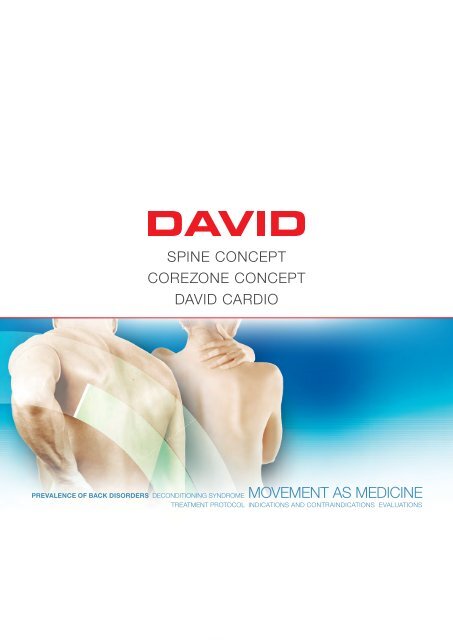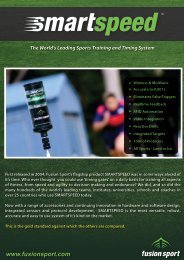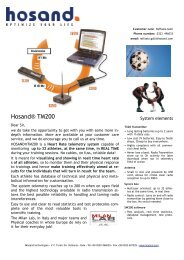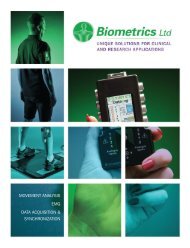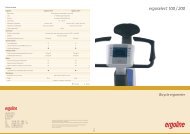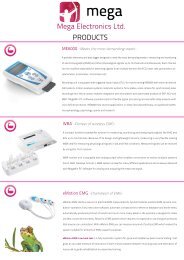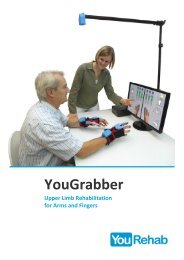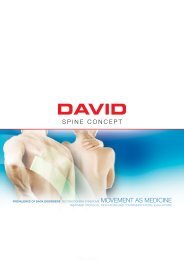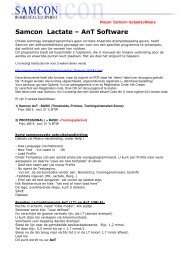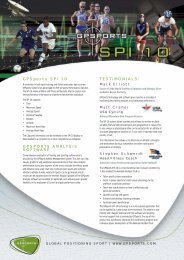spine concept corezone concept DaviD carDio - Samcon
spine concept corezone concept DaviD carDio - Samcon
spine concept corezone concept DaviD carDio - Samcon
- No tags were found...
You also want an ePaper? Increase the reach of your titles
YUMPU automatically turns print PDFs into web optimized ePapers that Google loves.
EVE Professional Web AccessWeb Access is used for viewing patient measurementand exercise data. Patient trainingprograms are generated using pre-existing templates.The center administrator can modify andcreate new templates if necessary. The programhas multiple reports including the <strong>spine</strong>profile analysis for a single patient or a selectedgroup. The daily activity report is a flexible toolfor monitoring the patient flow.The center administrator can modify the securityand visibility options of the data. In the defaultmode all data is restricted for clinic’s internal useonly. However, the clinic administrator can allowpatient data access to co-operating clinics ifnecessary. In co-operation mode two or moreclinics can share all their patient data.Center 2• Used with a web browser over a secure link• Tablet compatibility• Program access from anywhere in the world• No software installation requiredCentral Master Server• Centralized data gathering and storage• Real-time analyzation• Data distribution to connected centers• Automatic data backupCenter 3EVE Terminal User-Interface ViewsInstant training resultsBiofeedback during trainingRange-of-Motion testIsometric force testFor more information visit www.david.fi
SPINE CONCEPT COREZONE CARDIOThe DavidSpine ConceptOverall descriptionDavid Spine Concept is a comprehensive evaluation and treatment<strong>concept</strong> for back disorders. The <strong>concept</strong> uses carefullytargeted movement and controlled loading to reverse the deconditioningsyndrome related to back pain. Individualizedprograms are planned based on a questionnaire, physicalevaluations and tests. Specially designed devices provide asafe and effective way of improving mobility, strength and spinalcoordination. Full documentation and hands-on educationensures that any medical/physiotherapy facility can turn into aspecialized <strong>spine</strong> treatment center in a short time.Medical BackgroundPrevalence of back disordersBack pain is among the most common disorders in western societies causing more financial losses to companies and insurancesystems than any other single disorder except common cold. Up to 70 % of the people have experienced back pain sometime duringtheir lives; around 40 % had an episode lasting more than a day in the last 12 months and around 25 % during the past threemonths.Deconditioning syndromeIn most back pain cases, a specific diagnosis, such as disc hernia, is not possible to obtain. However, regardless of the reasonof the pain, it will cause avoidance in physical activity, further weakening the strength and coordination of the back and eventuallyaffecting the integrity of the tissue structure. This can produce a vicious cycle resulting in more pain and loss of function and ifprolonged, also psychological effects. When the problem has reached this level, traditional methods of treatment are helpless andthe possibility for permanent disability increases significantly as time passes.Movement as medicineSeveral studies have shown that movement can act as medicine for painful joints. With joints like the knee, which are relativelysimple structures, movements are simple and loading is easy to apply in a controlled manner. The <strong>spine</strong>, however, is a very complexstructure involving vertebrae, discs, ligaments, dynamically functioning rotator and intervertebrae muscles and large, mostlystatically functioning supporting muscles. When pain and loss of coordination is added into the equation, it is extremely difficult tostart physical exercises in a controlled manner. Special devices are required to isolate the target area provide total control in themovement and loading. All movements should start with limited range and low loading, within the pain tolerance. Time is essentialsince physiological changes are slow. Ideal treatment should run for three months with an ongoing program afterwards.
SPINE PROFILE GRAPHThe David Spine Concept treatment program consists of four distinctivelydifferent phases gradually turning an inactive and insecure patient into aconfident and able person to meet the demands of daily physical activitiesTreatment protocolEMG tests show how the David F110 Lumbar / Thoracic extension unit effectivelyeliminates strong hip extensors targeting the movement and loadingto the critical spinal region. Horizontal loading ensures low loads andminimal axial loading to the <strong>spine</strong> reducing pain during exercise.Indications and contraindicationsMost back disorders can be treated successfully with the David Spine Concept. These include unspecific back pain, degenerativechanges, herniations and post operative situations. Participation requires exclusion by a specialist of any contraindications andconsent by treating surgeon within four months of the surgery. Contraindications include tumours, acute inflammations, and recentfractures. Successful treatment requires patient consent and motivation to participate.EvaluationsIndividualized programs require thorough understanding of the patient background, present condition and physical capacity.A standard evaluation protocol includes a validated questionnaire including patient background, pain profiles and self assessment.Physical therapy evaluation assesses posture, functional deficiencies and limitations. Device based tests include strength andmobility in all movement plains. Results are recorded in a database and a very illustrative <strong>spine</strong> profile can be printed out comparingeach test to normative data. Evaluations done pre, mid and post provide objective outcome reports for treating doctors andthird‐party payers as well as added motivation for the patient.Treatment programThe duration of a recommended treatment program is 12 weeks and 24 sessions. The length is essential, since prolonged backpain causes physiological changes in the tissue structure of the back, which take time to recover. The program is divided intophases with specific objectives for each phase. The Orientation Phase (Fig. 1) aims at improving spinal movement in all movementplanes, segmental coordination of the <strong>spine</strong> and improving endurance capacity of the supporting muscles. During the AdaptationPhase coordination and endurance are further improved and loading is gradually increased within pain limits. Loading is increasedsystematically during the Exercise Phase to increase spinal stabilization and neural muscle control. During the Optimization Phasethe aim is to optimize and harmonize coordination, mobility and endurance capacity of the lower <strong>spine</strong> and neck. Throughout theprogram selective relaxation and stretching are used together with equipment based exercises. These combined with ergonomicguidance are also used in home training.Set-upDavid Spine Concept is a complete system including training and testing devices, evaluation protocol, software, documentation,education and support allowing any medical facility to start a <strong>spine</strong> rehab operation effectively and in a short period of time.For more information visit www.david.fi
SPINE CONCEPT COREZONE CARDIOThe Spine Concept DevicesGenration LineIn April 2013 David has launched a brand new device series, the David Generation Line. The first stage of this launch consists of theDavid Spine Concept devices. This new device line has brought a number of new exciting improvements to the time tested Daviddevice range. The improvements are not so much in the biomechanical features – as there was very little room here for development- but in the usability and technical detail.CompactThe new line is extremely compact, with an almost 50% smaller foot print than the preceding Future line. Part of this is due to thenew side loaded construction, which allows devices to be placed against walls or each other. Optimized design combining the powertransmission system, together with the weight stack frame, creates simplicity in the design and a smaller device size.SmoothNew power transmission technology, using aircraft cables and direct drive, make these devices completely silent with zero friction.The smoothness of the movement together with perfectly balanced movement arms and correct loading curves create a new level ofsafety and comfort even with the most delicate rehabilitation situations. As always, David relies on the most authentic and effectiveloading method, i.e. selected weights.EasyThe most striking improvements have to do with the ease of use of the devices. Entry to the devices is easy with low thresholds, fastfixations and now also with electronic adjustments. After finding the correct adjustments with the therapist the settings are storedin the cloud. The next time the patient touches the monitor with the rfiD card, adjustments are automatic. Improved fixations maketraining even safer and more targeted with fewer possibilities for in-correct movements.G110 DMS-EVELumbar/Thoracic ExtensionDavid G110 for Lumbar thoracic extension movement measures strengthand allows training of the extension of the lumbar and thoracic <strong>spine</strong> andmeasures mobility in the sagittal plane. It allows people with even severeand prolonged back pain and lack of coordination and strength tostart mobilization and strengthening exercises of the lumbar and thoracic<strong>spine</strong> with complete safety and minimal pain. This is made possible bythe unique hip fixation, which limits the exercise to the lumbar and thoracicarea practically eliminating the activation of the strong hip extensors.Movement is segmental, vertebrae by vertebrae, activating not only thestatic erector muscles but also the dynamic, but weak interspinales androtatores muscles between vertebrae.• Target muscles: Spinalis Thoracis, Iliocostalis Thoracis, Longissimus, IliocostalisLumborum, Spinalis, Intertrans versarii, Interspinalis• Measurements: Width 87 cm, length 126 cm, height 143 cm, weight 338 kgVariants:• Electroninc seat and footplate adjustments• Manual adjustmentsG120 DMS-EVELumbar/Thoracic RotationDavid G120 for Lumbar thoracic rotation measures strength and mobilityand allows training of the lumbar and thoracic <strong>spine</strong> in the transversalplane, allowing exercise with precise loading and range, fully adjusting tothe patient’s situation. The lower body is rotated while the upper body remainsfixed. The starting position – dependent on the mobility of the user –has adjustment in 10 degree intervals. This will provide a marked improvementto the motion control. The movement is carried out in two directions.The lumbar/thoracic rotation musculature is activated through eccentricand concentric movements. This allows for an extremely effective trainingof the oblique muscles (inner and outer lateral abdominal musculature)and the muscles of the transverse spinal system of the m. erector spinae.• Target muscles: Obliquus Externus, Obliquus Internus,Rotatores, Semispinalis, Multifidus• Measurements: Width 130 cm, length 113 cm, height 143 cm, weight 338 kgVariants:• Electroninc seat and footplate adjustments• Manual adjustments
G130 DMS-EVELumbar/Thoracic FlexionDavid G130 for lumbar thoracic flexion allows the measurementand training of the flexion of the lumbar and thoracic <strong>spine</strong>. Thehip-stabilizing mechanism and the curved back padding eliminatepotentially incorrect movement, which might cause stress to thelumbar <strong>spine</strong>. The result is an effective, dynamic segmental movementof the lumbar and thoracic vertebra, which will ultimatelystrengthen the abdominal musculature over its entire movementrange. The range of movement can be adjusted in steps, increasingpreliminary stretching of the elastic and contractile elementsof the agonist muscles. This exercise provides a most effectivemobilization of the thoracic <strong>spine</strong>.• Target muscles: Rectus Abdominus• Measurements: Width 87 cm, length 126 cm, height 158 cm, weight 345 kgVariants:• Electroninc seat and footplate adjustments• Manual adjustmentsG140 DMS-EVECervical Extension/Lateral FlexionDavid G140 for Cervical extension and flexion allows measurementof strength and training for the extension, lateral flexion and flexionof the cervical <strong>spine</strong>, and measurement of mobility in the sagittaland frontal planes. To determine load dosage, the same fundamentalprinciples used for the other functional exercises of the <strong>concept</strong> areapplied. The risk of over exertion is minimized by a precisely calculatedload resistance for all the varying individual training plans. Newlyimproved smoothness in the movement makes this device an evenmore important part of the Spine Concept.• Target muscles: Splenius, Erector Spinae, Levator Scapulae,Trapezius, Sternocleidom., Longus Colli, Scalenus ant., Longus Capitis• Measurements: Width 108 cm, length 98 cm, height 169 cm, weight 196 kgVariants:• Electroninc seat adjustment• Manual adjustmentsG150 DMS-EVELumbar/Thoracic Lateral FlexionDavid G150 for Lumbar thoracic lateral flexion is used to quantifythe mobility of the lumbar and thoracic <strong>spine</strong> in the frontal planeand to analyze and train the muscle strength and/or functional capacityof the isolated lumbar/thoracic lateral-flexion musculature.Analogue to the G110 and G130 units, the patient or user – dependingon the position of L3 /L4 vertebra – is positioned correctlyaccording to the axis of rotation of the exercise device in relationto the body. The torso or shoulder axis is fixed via a shoulderstabilizingmechanism. As with the David G120, the movement iscarried out in two directions, allowing the lumbar/thoracic lateralflexionmusculature to be activated by eccentric and concentricmovements as well.• Target muscles: Quadratus Lumborum, Psoas Major• Measurements: Width 96 cm, length 114 cm, height 143 cm, weight 305 kgVariants:• Electroninc seat adjustment• Manual adjustmentsFor more information visit www.david.fi
SPINE CONCEPT COREZONE CARDIOSpine ConceptCoreZone® ConceptBack pain is among the most common disorders in westernsocieties causing more financial losses to companies and insurancesystems than any other single disorder, except the commoncold. The CoreZone Concept has been designed to tacklethis problem in a cost-effective, simple and yet effective way.Hip & Knee ConceptSimilar to the Spine Concept the CoreZone focuses on conditioningof the bodies core muscles, utilising David’s preventionline of equipment, P1100 Body Traction, P1110 Back Extension,P1130 Abdominal Flexion, P1131, Abdominal Contraction andP1150 Lateral Flexion.The <strong>concept</strong> is targetted to fitness centers, physiotherapy clinicsand companies that want a targeted solution in preventingback problems. Shoulder The CoreZone Concept allows for exercises at differentintensity levels – beginner, intermediate and advanced. Thecompact size and transportability of the equipment allows forthe <strong>concept</strong> to be used as part of a training circuit. The simplicityof the solution means that taking care of the core muscles ofthe body has never been easier.EquipmentA full core workout can be done in only 15 minutes depending on the difficultylevel. Core training supplements often cardio dominated group training verywell. A healthy back is a solid foundation for a healthy and active lifestyle.P1110Back Extension• Target muscles: Back and Shoulder muscles, Hip extensors• Simple and user friendly solution for mobilization of the lumbarand thoracal <strong>spine</strong> and for the strengthening of the hip,back and shoulder muscles.• Contoured support pad• Easy adjustment and foot support for optimized, individualphysiological body positioning• Wheels for easy re-positioning (also for seniors)• Measurements: Width 72cm, Length 137cm, Height 92cm,Weight 44kgP1130Abdominal Flexion• Target muscles: Abdominal muscles• Effective, isolated exercise. Dynamic, sequential movementthat is optimized with a contoured lordose support for mobilizationof the lumbar and thoracal <strong>spine</strong> and strengtheningof the abdominal muscles• Hip-joint fixation with a unique, patented mechanism (HiplocK),handle for easy entry / exit• Hip-joint flexors are kept inactive through the use of Hip-Lock• Adjustable range of movement and training load (upper bodyweight) with a simple tilt mechanism• Measurements: Width 72cm, Length 163cm, Height 138cm,Weight 55kg
Spine ConceptPREVENTION LINECoreZone Spine ® Concept ConceptSpine ConceptHip & Knee ConceptPREVENTION LINECoreZoneP1131 ® ConceptAbdominal ContractionShoulder ConceptCoreZone® ConceptHip & Knee ConceptSpine Concept1GENERAL GUIDES2Shoulder ConceptSpine Concept1. Adjusting the back rest position.PREVENTION LINE2. Releasing the knee support pop pin.CoreZoneSpine Concept P1130 ® ConceptHip & Knee ConceptAbdominal FlexionCoreZone® ConceptSpine ConceptHip & Knee ConceptPREVENTION LINEGENERAL GUIDES1 2 3CoreZoneP1110 ® ConceptShoulder ConceptBack ExtensionCoreZone® 1. Attaching / removing the back supportConceptfeet2. Adjusting the seat inclineShoulder on the lowest Concept foot support. Support your body withHip & Knee ConceptHip & Knee Conceptyour left arm and, if needed, grab the handle with your3. Knee support lever operationright hand. Lift your upper body (bending your right side);David Prevention Line is set of special benches for physiotherapy use.Shoulder Conceptassist with your arms if needed. Return slowly to thesit on the seat pad and place your feet on theThese benches have fixations and handles that will enable very controlled training ofinitial position and repeat. Perform 2 sets of 8–12 repetitions.Then lie down on the bench on your right side andlowest foot pegs. Roll your upper torso forwardin a smooth, controlled manner. Returnisolated body parts in an effective and safe manner.Hip & Knee ConceptShoulder Concept slowly to the initial position and repeat. Perform2 sets of 8–12 repetitions. Keep yourrepeat the movement to the opposite directionPrevention Line benches complement well any other David Line.arms crossed on your chest. Round your backthe lever (next to the handle) and incline the seatduring the movement (segmental flexion / extension)in order to activate the abdominalShoulder Concept to 40–50º. Sit on the seat pad, place your feet onBEGINNERthe foot support, release the knee pad lever andmuscles.adjust it tightly on your knees. Roll your upperRemove the knee support and sit on large pad placingyour thighs under the thigh pad. Adjust the thigh pad totorso forward slowly and steady. Return slowlythe lowest position (above the thighs). Keep your armsto the initial position and repeat. Perform 2 setsat your sides and bend your upper body from your pelvisof 10–20 repetitions. Keep your arms crossed onforward / downward. Exhale when in the lowest position.your chest. Round your back during the movement(segmental flexion / extension) in order toExtend your back and repeat the movement. Perform 2sets with 15–25 repetitions. Round your back during theactivate the abdominal muscles.movement (segmental flexion / extension) so that theback extensor muscles are activated.feet on one of the mid foot supports. First, let your upperbody bend downwards (to the left) and, then, lift itsit on the seat pad and place your feet on theup (bending your right side). Return slowly to the initialhighest foot pegs of the lower foot supports.position and repeat. Perform 2 sets of 10–20 repetitions.Roll your upper torso forward in a smooth, controlledmanner. Return slowly to the initial posi-the movement to the opposite direction.Then lie down on the bench on your right side and repeattion and repeat. Perform 2 sets of 10–20 repetitions.Keep your arms crossed on your chest.Round your back during the movement (segmentalflexion / extension) in order to activatethe abdominal muscles.INTERMEDIATEReplace the knee pad, open the thumb screw, lift up thepop pin and adjust the thigh pad so that your your torsomoves freely from your pelvis upward. Place your kneesagainst the pads and your feet against the foot supportpins. Keep your arms at your sides. Bend your upper bodyfrom your pelvis forward / downward. Exhale when in thelowest position. Extend your back and repeat the movement.Perform 2 sets with 15–25 repetitions. Round yourback during the movement (segmental flexion / extension)so that the back extensor muscles are activated.ADVANCEDReplace the knee pad, open the thumb screw, lift upthe pop pin and adjust the thigh pad so that your yourtorso moves freely from your pelvis upward. Place yourknees against the knee pads and your feet against thefoot support pins. Keep your arms at your sides. Bendyour upper body from your pelvis forward / downward.Exhale when in the lowest position. Extend your back andrepeat the movement. Perform 3 sets with 20–30 repetitions.Round your back during the movement (segmentalflexion / extension) so that the back extensor musclesare activated.Additional ExercisesHip Joint Extension for Gluteal andHamstring MusclesReplace the knee pad, open the thumb screw, lift up the pop pinand adjust the thigh pad to the lowest position.Place your knees against the knee pads and feet against thefoot support pins.Start the movement by lowering your torso to a horizontal levelor little below that. Extend you torso slowly and steady. Repeatthe movement. During the exercise keep your hands behindyour head and your <strong>spine</strong> straight in order to activate the Glutealand Hamstring Muscles.lease the lever (next to the handle) and inclinethe seat to 30–40º. Sit on the seat pad, placeyour feet on the foot support, release the kneepad lever and adjust it tightly on your knees.Roll your upper torso forward slowly and steady.Return slowly to the initial position and repeat.Perform 2 sets of 10–20 repetitions. Keep yourarms crossed on your chest. Round your backduring the movement (segmental flexion / extension)in order to activate the abdominal muscleslease the lever (next to the handle) and inclinethe seat to 20–30º. Sit on the seat pad, placeyour feet on the foot support, release the kneepad lever and adjust it tightly on your knees.Roll your upper torso forward slowly and steady.Return slowly to the initial position and repeat.Perform 2 sets of 15–25 repetitions. Keep yourarms crossed on your chest. Round your backduring the movement (segmental flexion / extension)in order to activate the abdominal muscles.Additional ExercisesAbdominal RotationAdd in an upper torso rotation to the movement,alternating to left and right in the end of the movement.sit on the seat pad and place your feet on theupper foot pegs. Release the knee pad pop pinand place the pad firmly on your thighs. Rollyour upper torso forward in a smooth, controlledmanner. Return slowly to the initial positionand repeat. Perform 2 sets of 15–25 repetitions.Keep your arms crossed on your chest.Round your back during the movement (segmentalflexion / extension) in order to activatethe abdominal muscles.Spine ConceptCoreZone® ConceptHip & Knee ConceptShoulder Conceptfeet on one of the upper foot supports. First, let your upperbody bend downwards (to the left) and, then, lift itup (bending your right side). Return slowly to the initialposition and repeat. Perform 2 sets of 15–25 repetitions.Keep your arms crossed on your chest. Then lie downon the bench on your right side and repeat the movementto the opposite direction.Additional ExercisesUpper Body TwistsBring a stick or a light weight bar behind your head and rest it on yourshoulders. Sit down on the front of the bench and hold your feet sturdy onthe floor.Perform the movement by twisting your upper body from side to side.Spine ConceptCoreZone® ConceptHip & Knee ConceptShoulder ConceptSpine ConceptPREVENTION LINECoreZone® ConceptHip & Knee ConceptSpine ConceptTO Shoulder STARTConceptStep on the footsteps, pull up the safety grips andadjust the elbow pads close to your body.CoreZone® ConceptHold tightly on the handles, place your elbows onthe pads and your back against the roller padHip & Knee ConceptKeeping your feet on the footsteps,stretch out your <strong>spine</strong> while supportingwith your feet. Repeat 5–10 timesShoulder Conceptholding the position for 10 seconds.Exhale during the stretch. Finish withstretching for 15–30 seconds.Take your feet off the footsteps, stretchout your <strong>spine</strong> for 5–10 seconds.Repeat 5–10 times. Exhale duringthe stretch. Finish with stretching for30–60 seconds.Take your feet off the footsteps, stretchout your <strong>spine</strong> and perform 3 x 10 lowerbody twists to both directions withoutbending your knees. Finish withstretching for 30–60 seconds.Additional ExercisesLeg RaiseStep on the footsteps, pull up the safety grips andadjust the elbow pads close to your body.Hold tightly on the handles, place your elbows onthe pads and your back against the roller pad.Take your feet off the footsteps.Lift your knees up a little above parallel.Return to the initial position slowly and repeat.PREVENTION LINESpine ConceptCoreZone® ConceptHip & Knee ConceptShoulder ConceptAlternating Leg RaiseStep on the footsteps, lift the safety grips up and adjustthe elbow pads close to your body.Hold tightly on the handles, place your elbows on thepads and your back against the roller pad.Take your feet off the footsteps.Lift your left knee up a little above parallel; stop for1–2 seconds. Lower your left leg while lifting your rightknee up a little above parallel, stop for 1–2 seconds.Repeat the movement in a smooth, controlled manner.P1131Abdominal Contraction• Target muscles: Abdominal Flexor Group• Hip-Lock system for effective isolation of the Abdominalmuscles• Gradual adjustment for intensified exercise positioning• Handle for easy entry / exit (also for seniors)• Contoured back support• Wheels for easy re-positioning (also for seniors)• Measurements: Width 72cm, Length 169cm, Height 129cm,Weight 66kgP1150Lateral Flexion• Adjustable back support and ankle rolls for stable positioning• Movement arm adjustment to accommodate various users(maa)• Contoured seat and back support for additional safety andcomfort• Lever for easy entry / exit, also enables full range movement• Seat belt for additional stability during exercise• Unilateral exercise• Target Muscles: Vastus Medialis, Vastus Lateralis, VastusIntermedius, Rectus Femoris• Measurements: Width 86 cm, length 142 cm, height 133 cm,weight 320 kgP1100Body Traction• Target muscles: Trapezius, Abdominal muscles, Spinalmusculature• The only device that allows traction of the <strong>spine</strong> in an uprightposition• Ingenious mechanical construction and utilization of neuromotoricprinciples allow complete stretching of the backextensor musculature with simultaneous unloading of thehip joints• Mobilization of the thoracal <strong>spine</strong>, strengthening of the backand abdominal muscles• Effective fixation of the arms and shoulder blades is achievedthrough the TRIANGLE-lock mechanism; Physiologically optimalpositioning of the user• Measurements: Width 78cm, Length 94cm, Height 194cm,Weight 82kgP1100 Body TractionSpine ConceptBEGINNERAttach the support pad to the back rest. ReleaseINTERMEDIATERemove the support pad from the back rest. Re-ADVANCEDRemove the support pad from the back rest. Re-BEGINNERAdjust the back rest to the highest position;INTERMEDIATEAdjust the back rest to the middle position;ADVANCEDAdjust the back rest to the lowest position;P1150 Lateral FlexionBEGINNERLie down on the bench on your left side and place yourINTERMEDIATELie down on the bench on your left side and place yourADVANCEDLie down on the bench on your left side and place yourBEGINNERINTERMEDIATEADVANCEDCoreZone® ConceptHip & Knee ConceptShoulder ConceptThe <strong>concept</strong> includes 5 posters (A1 size)that guide through the exercises in differentintensity levels. A detailed <strong>concept</strong> manualfor the service provider is also included.PREVENTION LINEIN THE ENDWhen finished, pull up the safety grips and adjust the elbow pads to the lowest position.CONCEPT MANUALFor more information visit www.david.fi
SPINE CONCEPT COREZONE CARDIODavid CARDioDavid Cardio line offers integration with theDavid EVE -system allowing full control in theplanning, training and follow-up. All deviceterminals are wirelessly connected to theeve central server for remote control. Sleekdesign with small footprint makes David cardiodevices ideal additions to David Spine,Hip & Knee and Shoulder <strong>concept</strong>s. Davidcardio line offers five different models, twocycles, cross trainer, treadmill and an upperbody cycle.CYCLE-UP EVE• Resistance 25 - 500 Watts• rpm 40 - 120• Maximum user weight 150kg• Polar pulse connection• Medical-ce approved• Measurements (L x W x H): 120 x 60 x 145 cm• Weight 46 kgOptions:• Test program package• Serial connection• Adjustable crank arm• Hand pulse connection• Ear pulse connection• User weight extension 200 kgCYCLE-REC EVE• Resistance 25 - 500 Watts• rpm 40 - 120• Maximum user weight 150 kg• Polar pulse connection• Medical-ce approved• Measurements (L x W x H): 159 x 65 x 137 cm• Weight 46 kgOptions:• Adjustable crank arm• Adjustable back rest• Hand pulse connection• Ear pulse connection• User weight extension to 250 kg with rotary seat
BODY EVE• Resistance 25 - 500 Watts• rpm 40 - 120• Maximum user weight 150 kg• Polar pulse connection• Medical-ce approved• Measure ments (L x W x H): 122 x 80 x 174 cm• Weight 108 kgOptions:• Adjustable crank arm• User weight extension to 200 kgTREAD EVE• Incline -3 to 12 degrees• Speed 0 - 17 km/h in 0,1 intervals• Maximum user weight 150 kg• Polar pulse connection• Medical-ce approved• Measurements (L x W x H): 198 x 79 x 145 cm• Weight 170 kgOptions:• Arm pulse connection• Ear pulse connection• User weight extension to 250 kg• Speed extension to 24 km/h• Bi-directional belt driveCROSS EVE• Resistance 25 - 500 Watts• rpm 40-80• Maximum user weight 150 kg• Polar pulse connection• Medical-ce approved• Measurements (L x W x H): 215 x 65 x 157 cm• Weight 118 kgOptions:• Arm pulse connection• Ear pulse connection• User weight extension to 200 kgFor more information visit www.david.fi
David Health solutionsHeadQUARTERSAddress pasilanraitio 500240 HelsinkiFinlandPhone +358 20 759 7300Fax +358 20 759 7301General infoinfo@david.fiSalessales@david.fiService and Spare partsservice@david.fiWebwww.david.fiGerMan Branch OfficeAddress liebknechtstr. 33D-70565 Stuttgart-VaihingenGermanypHone +49 711 78 11 85 20fax +49 711 78 11 85 21e-mailinfo-de@david.fiuk Branch OfficeAddress21 Mission Road, BroadstoneDorset, BH18 8JJunited KingdomContactDan ricepHone +44 798 935 214e-maildan.rice@david.fiRev. 5


